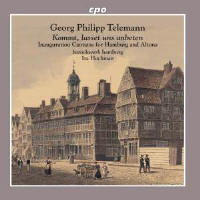Texte paru dans: / Appeared in: |
|
|
Reviewer: James
A. Altena
The release of this recording,
made January 31—February 2, 2018, has a coincidental but almost uncanny
prescience for the fire that destroyed the roof of Notre Dame church in
Paris on April 15 of this year. On March 10, 1750, a winter storm broke over
the city of Hamburg. At about 10:45 am a bolt of lightning struck the tower
of the Michaeliskirche, built in 1647–69 and one of the city’s five main
churches. Around 1:00 pm smoke and steam were observed issuing from there
and in another 15 minutes a full-scale fire became manifest, which within
another 45 minutes consumed the entire building. Stone graves in the church
shattered from the heat and remained on fire for another day. It would
require 12 years to erect a new building, which was not fully finished until
1786. The church has suffered severe damage from fire twice more since then,
first in 1906 during construction work and then in 1944–45 from Allied
bombing raids; it is still being reconstructed from the latter episode. In
contrast to the much more secular-minded present day, where political anger
has been voiced over expenditure of money to rebuild a world-renowned
historic cathedral taking priority over economic claims for “social
justice,” the political and religious authorities in Hamburg declared that
the destruction of the church was an expression both of God’s wrath against
widespread sinfulness in the city, and of his mercy in sparing the city far
worse punishment and providing its citizens with time and space for
repentance.
Consequently, the service for
the solemn rededication of the new church on October 19, 1762, including the
oratorio text penned for Telemann by Johann Daniel Zimmermann, archdeacon of
the city’s Katharinenkirche, emphasized the themes of the day. Expressions
of amazement, reverent fear, repentance, and lamentation fill the first half
of the oratorio, which contemplates the catastrophe; those of supplication,
praise, thanksgiving, and rejoicing comprise the second half, which
considers the new structure erected to God’s glory. The 81-year-old Telemann,
a resident of Hamburg since 1721 and indisputably the greatest living
composer of his day, employed his skills to produce one of his finest and
most expressive works. I never cease to be amazed at both his fecund genius
and his seemingly inexhaustible powers of invention; unlike so many of his
contemporaries he seldom falls prey to superficiality and formulaic
note-spinning. This is a masterpiece not far behind the Bach passions and
Handel’s Messiah in quality. The performance, while solid, is not quite on the level of the music. Conductor Michael Alexander Willens, the instrumentalists, and the choristers, are superb; the problems lie with the soloists. In several previous reviews, I have noted that the voice of distinguished bass Klaus Mertens has become increasingly dry and hard-toned. To that can now be added an encroaching unsteadiness and a tendency to bark rather than sing. (Klaus, you’ve had a magnificent career, but it’s time to hang up the cleats and take up coaching instead.) Tenor Julian Podger is a second-stringer, with an undistinguished voice and some degree of unsteadiness as well. The two of them (present primarily in the first half of the oratorio) are not unbearable, but they do let down the side to some degree. Soprano Rahle Maas is considerably better, but not quite first-rate. The two distinguished soloists are the second bass, Mauro Borgioni, and alto Marian Dijkhuizen, who both have beautifully rich, vibrant, well-schooled voices and are effective interpreters. Mertens and Borgioni have the lion’s shares of the solo work. The proceedings are well recorded, and CPO provides a detailed booklet with an informative essay, artist bios, and German-English libretto. In sum, despite the deficiencies just noted, this disc warrants a firm recommendation for the oratorio itself as a major addition to both the Telemann and sacred Baroque discographies.
| |
|
|
|
|
|
|
|
Cliquez l'un ou l'autre
bouton pour découvrir bien d'autres critiques de CD |
|




